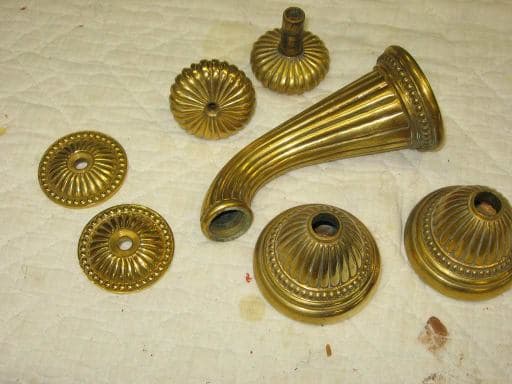
Curated with aloha by
Ted Mooney, P.E. RET

The authoritative public forum
for Metal Finishing 1989-2025

-----
Bath Fittings from the early 50's Portugal- could they be Gold?
My Grandmother had these Gold bath fittings, (tub spout, two water knobs with large ornate backplates), and her husband was a U.S. Ambassador who traveled extensively through Europe. I was always told they were Gold, they show absolutely no tarnishing and are extremely heavy for their size. They are clearly hand made, and hand shaped. The ONLY mark on them is the word "Portugal" shaped in a semicircle on the back of the spout. I accidentally dropped one on the garage floor and it easily distorted the edge of one of the backplates, so this is fairly soft metal.I tried undiluted Muriatic acid on one of the backplates, and it had no effect at all. What are the chances these are Gold? Could they be 9K or some other more obscure weight? I did take a backplate to a local jeweler, and he dismissed it as Brass without even really looking at it...he didn't even hold it. How can I be sure? Thanks for any help.

furniture restorer - Middlebury, Connecticut
October 16, 2009
Even in the early 50s the cost of gold alloys would have been prohibitive. They could easily be gold plated brass which was fairly common.

Jeffrey Holmes, CEF
Spartanburg, South Carolina
October 19, 2009
Thanks for the reply Jeff, Money wasn't really a problem for them , (the house sold for almost 3 million after her death), and these do not look plated.....her furniture was Museum quality European Antiques as well,and then there's the Art...you get the idea... so to me, it isn't a stretch to imagine that these could be Gold, my question is, how can I have it tested, or otherwise prove it once and for all? I've seen how the Pawn shops use a little piece of emery cloth to remove some of the metal and then use a solution of some type to test the material on the emery cloth ...is this an accurate test, for any alloy of Gold? Thanks again.
Greg Scholl- Middlebury, CT. USA
October 21, 2009
First of two simultaneous responses --
Greg, the specific gravity (density) of brass is 8.2 to 8.6, depending on the type of brass. The specific gravity of gold is 19.3. A quick and simple determination of the specific gravity of each of your items by water immersion, should make it quite clear which you have.
I suppose there is perhaps a possibility of some base metal other than brass that has been plated, but all likely base metals have specific gravities that are far removed from that of gold. Even lead, just in case a lead-antimony alloy was used, is only 11.3.

Bill Reynolds [deceased]
consultant metallurgist - Ballarat, Victoria, Australia
We sadly relate the news that Bill passed away on Jan. 29, 2010.
October 21, 2009
Second of two simultaneous responses --
Clean off a small area with sandpaper to be certain you've removed any lacquer coating and any thin layer of gold plating. Apply a few drops of concentrated nitric acid. If nothing happens, they're gold. If there's bubbling, color change or fumes, they are not gold.
If you're unfamiliar with safely handling nitric acid, find someone who is qualified. It's nasty stuff which destroys flesh on contact.
You're more likely to win the lottery than to find that these are gold.

Jeffrey Holmes, CEF
Spartanburg, South Carolina
October 21, 2009
I would be willing to scrape shavings of this metal and send them to someone who has access to concentrated acid, as that's not something easy to procure...or even send one piece for more extensive testing....I just don't know who to ask...is this something you might do Jeff?Thanks for all the help!
Greg Scholl- Middlebury
October 24, 2009
Q, A, or Comment on THIS thread -or- Start a NEW Thread